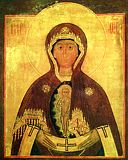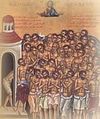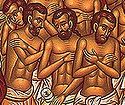

| Previous day | Next day |
| Old Style
March 9
|
Thursday |
New Style
March 22
|
|
5th Week of Great Lent.
Tone 8.
Great Lent. |
Wine and oil allowed.
|
The Holy Forty Martyrs of Sebaste: Cyrion (or Quirio), Candidus, Domnus, Hesychius, Heraclius, Smaragdus, Eunoicus, Valens, Vivianus, Claudius, Priscus, Theodulus, Eutychius, John, Xanthias, Helianus, Sisinius, Angus, Aetius, Flavius, Acacius, Ecdicius, Lysimachus, Alexander, Elias, Gorgonius, Theophilus, Dometian, Gaius, Leontius, Athanasius, Cyril, Sacerdon, Nicholas, Valerius, Philoctimon, Severian, Chudion, Aglaius, and Meliton (ca. 320).
Martyr Urpasianus of Nicomedia (ca. 295). St. Caesarius, brother of St. Gregory the Theologian (ca. 369). St. Tarasius the Wonderworker, of Lycaonia. Translation to Vladimir of the relics of Martyr Abraham of the Bulgars on the Volga (1230). St. Jonah, archbishop of Novgorod (1470). St. Theodosius Levitsky, priest, of Balta (Odessa) (1845). St. Dimitra, nun and foundress of the Vvedensk Convent in Kiev (1878).
New Hieromartyrs Mitrophan Buchnoff, archpriest, of Voronezh (1931), and Ioasaph (Shakhov), abbot, of Popovka (Moscow) (1938). New Hieromartyrs Sergius Lebedev, Sergius Tsvetkov, and Alexis Smirnov, archpriests, and Dimitry Glivenko, priest, all of the Moscow region (1938).
“Albazin” Icon of the Most Holy Theotokos (“The Word Was Made Flesh”) (1666).
St. Philoromus the Confessor, of Galatia (4th c.). St. Pacianus, bishop of Barcelona (390). St. Bosa, bishop of York (705). St. Vitalis of Castronovo (994). New Martyrs (two priests and forty students) of Momisici (Montenegro) (1688).
Repose of Elder Cleopas of Ostrov-Vvedensk Monastery (1778) and Schema-archimandrite Theophilus of Kiev (1996).
Thoughts for Each Day of the Year
According to the Daily Church Readings from the Word of God
By St. Theophan the Recluse

Thursday.
A haughty spirit goeth before a fall (Prov. 16:18).[1] Therefore, do not allow evil thoughts to come in, and there will be no falls. And yet what are people most careless about? About their thoughts. They allow them to seethe as much and however they like, not even thinking to subdue them, or to direct them to rational pursuits. Meanwhile, within this inner turmoil the enemy approaches, places evil in the heart, seduces it and inclines it toward evil. And the person unnoticeably prepares himself for evil. It remains for him to either carry out the evil fixed to his heart, or to struggle with it. But this is our sorrow: that almost nobody takes on the struggle; while all are led to the evil as if bound.
[1] The Slavonic for Prov. 16:18 reads: Evil thoughts go before a fall. Probably St. Theophan used the Slavonic version as he wrote, but the editor used the Russian version, and so the editor added the words, “evil thoughts” in parentheses in my version of the text).
Articles
 Martyr Urpasianus of NicomediaThe Holy Martyr Urpasianus suffered in the city of Nicomedia. |
 St. Caesarius, brother of St. Gregory the TheologianSaint Caesarius lived for a long time at the court of the emperor Constantius (337-361), and was his friend and chief court physician. |
 Icon of the Mother of God “The Word was made Flesh”The Albazin Icon of the Mother of God “the Word made Flesh” is of great religious significance in the Amur River region. |






